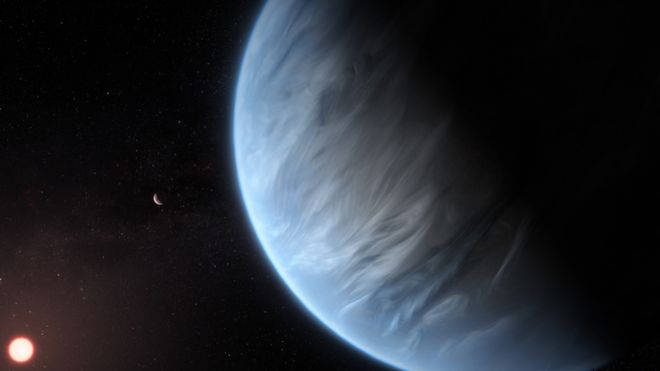Water found for first time on ‘potentially habitable’ planet:
Astronomers have for the first time discovered water in the atmosphere of a planet orbiting within the habitable zone of a distant star.
The finding makes the world – which is called K2-18b – a plausible candidate in the search for alien life.
Within 10 years, new space telescopes might be able to determine whether K2-18b’s atmosphere contains gases that could be produced by living organisms.
Details were published in the scientific journal Nature Astronomy.
The lead scientist, Prof Giovanna Tinetti of University College London (UCL), described the discovery as “mind-blowing”.
“This is the first time that we have detected water on a planet in the habitable zone around a star where the temperature is potentially compatible with the presence of life,” she said.
The habitable zone is the region around a star where temperatures are considered sufficiently benign for water to exist in liquid form on the surface of a planet.
The new planet is just over twice the size of Earth – in a planet category known as a “super-Earth” – and has a temperature cool enough to have liquid water, between zero and 40C.
K2-18b is 111 light-years – about 650 million million miles – from Earth, too far to send a probe. So the only option is to wait for the next generation of space telescopes to be launched in the 2020s and to look for gases in the planet’s atmosphere that could only be produced by living organisms.
What is an exoplanet?
Planets beyond our Solar System are called exoplanets
The first exoplanet was discovered in 1992, orbiting a pulsar (a neutron star that emits electromagnetic radiation)
More than 4,000 have been detected to date using several techniques
Many of these worlds are large planets believed to resemble Jupiter or Neptune
Many giant planets have been found orbiting very close to their stars
The team behind the discovery looked through the planets discovered by the Hubble Space Telescope between 2016 and 2017. The researchers determined some of the chemicals in their atmosphere by studying the changes to the starlight as the planets orbited their suns. The light filtered through the planets’ atmospheres was subtly altered by the composition of the atmosphere.
Only K2-18b revealed the molecular signature of water, which is a vital ingredient for life on Earth.
Dr Angelos Tsiaras, a member of the UCL team, said that finding water in the atmosphere of a “potentially habitable exoplanet was incredibly exciting”.
Other astronomers, however, dispute the claim that the planet is potentially habitable. One analysis indicates that planets that are 1.5 times the mass of the Earth are unlikely to have a rocky surface. There is also concern that K2-18b’s size and gravity would make it difficult for the world to support life.
Other critics suggest that the planet should not be classified as a super-Earth, but as a mini Neptune instead. This is a class of planet that is typically more massive than a super-Earth (it includes worlds that are up to 10 times the mass of our own planet). Prof Tinetti, however, maintains her view that the new world is potentially habitable.
She said it had a mean density that’s comparable to that of Mars (which is composed of silicates) and Jupiter’s moon Europa, and much higher than Neptune’s.
“K2-18b cannot be classified as a mini-Neptune, it is more likely to be a planet with an interior of rock and ices. These types of planets, [are] sometimes called ‘ocean planets’,” she told BBC News.
“Now, whether this planet really has an ocean at the surface or rock, we cannot tell with current observations, but having water in the atmosphere is a good start.”
But it is a view that Dr Laura Kreidberg, of the Centre for Astrophysics at Harvard University does not agree with.
“The interior of the planet is much more like Neptune. Pressure and temperature increase with depth, so that before a rocky surface is reached, it is too hot and too high-pressure for complex molecules like DNA or any of the other building blocks of life to form,” she told BBC News.
Prof David Charbonneau, also from Harvard University, said the fact that K2-18b’s atmosphere was detected was proof in itself that it could not support life.

“If the planet had a thin secondary atmosphere similar to Earth it would be so thin that Hubble couldn’t detect it.”
Long haul
Another issue is that astronomers can’t agree what conditions are needed for habitability. We only have the Earth to go on but life may also be possible on other types of worlds
It is likely to require a survey of the chemical composition of, perhaps, hundreds of worlds and an understanding of how they are created and evolve, according to Prof Tinetti.
“The Earth really stands out in our own Solar System. It has oxygen, water, and ozone. But if we find all that around a planet around a distant star we have to be cautious about saying that it supports life,” she said.
“This is why we need to understand not just a handful of planets in the galaxy but hundreds of them. And what we hope is that the habitable planets will stand out, that we will see a big difference between the planets that are habitable and the ones that are not.”




